Does Well Water Stain Foliage?
Does well water stain foliage? Loaded question. And the short answer is yes – and it happens when that well water is loaded with the Earth’s two most bodacious forms of iron. Stick around, have a read, and watch the included vid. It’s all pretty informative.
By John G. Stamos
Table of Contents
When Does Well Water Stain Foliage?
“Will well water stain foliage in my garden?” I was recently asked this question by one of my neighbors. The question was relevant because this particular neighbor is new to gardening, and every house in the immediate vicinity of my own hardiness zone 5B/6A property relies on a well for its water supply – including my neophytic gardening neighbor’s domicile. And, unless a particular homeowner has elected to run all of the water that issues from his or her outdoor hose bibb(s) through his or her indoor water softening system (this rarely happens because it’s an expensive and impractical proposition), that supply of unadulterated well water is what comes out of most Michiana Shores garden hoses. And, in the case of all Michiana Shores homes, that well water is heavily laden with iron. And, depending on the kinds of iron that are in that well water, it can and does stain plant foliage.
In this article, I’ll give you the three most common forms of iron that can show up in well water, with a brief explanation of each one. I’ll identify the foliage-staining culprits of the bunch (and the problems with plants that the stains themselves cause), as well as the necessary conditions (the things you should definitely avoid doing if you’ve got it lurking in your own well water) for it to work its nasty magic. I’ll explain why products that are advertised as “liquid iron” that can be applied to plants as a foliar and/or root drench DO NOT stain foliage, and I’ll give you my personal recommendation for the one I consider to be the best and most effective. I’ll give you a link to a video I just recently made for The Renaissance Garden Guy YouTube Channel that puts the whole issue into an easy-to-understand, viewable perspective. Finally, you’ll get a bibliography of the info sources I used to help me write this article, with links you can click in case you’d like to learn more about this topic.
There are 3 types of iron most frequently found in well water, and two of them definitely stain foliage.
Ferrous iron, ferric iron, and organic iron are three forms of iron commonly found, in varying combinations and proportions, in well water. Of these three types of iron, the first two are those most often found in residential well water.¹⁻³ My well water, according to the results of my most recent water analysis, contains only the first two forms (it’s unlikely that a more accurate and expensive test would detect traces of the other form, so for all intents and purposes, and certainly for the purposes of this article, ferrous and ferric iron are the only two that I’ve got in my water and the only two that are relevant). And it just so happens that ferrous iron and ferric iron are the two forms of iron that stain plant foliage.⁴ Here’s a little info about each of the forms.
Ferrous iron. Ferrous iron, chemical symbol Fe²⁺, is an iron cation (a positively charged iron ion). It’s iron in a water-soluble form, so it’s highly soluble in soil and super easy for garden plants to assimiliate through their root systems. When ferrous iron exists in compound form, as a ferrous sulfate, it’s simple for plant foliage to absorb it, too. In this compound form, ferrous iron is used commercially as a foliar drench (there’s more on that just a bit later). Ferrous iron, since it’s water-soluble, isn’t visible when it’s present in well water – it’s invisible, and the water that it contains it is clear. Ah, here’s the rub… when ferrous iron is exposed to oxygen in the open air, that oxygen works as an oxidizing agent and causes ferrous iron, Fe ²⁺ (the little “²⁺” means that it’s an ion that’s positively charged by the amount of exactly two protons with respect to its electrons), to lose electrons and become more positively charged. How much more positively charged? By exactly one proton. So, guess what? Fe²⁺ has now been converted in the open air, through the process of oxidation, to Fe³⁺, aka ferric iron.⁵⁻⁶ And, as you’ll read immediately below, this is gonna have some serious foliage staining implications…
Ferric iron. Ferric iron, chemical symbol Fe³⁺, like ferrous iron, is an iron cation. This is iron in a form that is not water-soluble. Instead, it exists in well water as a particulate (tiny rust-colored chunks). In a clear glass, well water that’s got ferric iron in it is reddish/brownish-looking due to the tiny, non-water-soluble rusty-looking iron particles suspended in it. Although ferric iron is not water-soluble, and many early studies suggested that it was not absorbed by plant roots (it was thought that it first needed to be chemically reduced to Fe²⁺ form before it could be assimilated by a particular plant’s root system), it actually can be, and is, absorbed by plant roots in its ferric cation state.⁷ (I discussed this fact briefly in my RGG article, “Granular Iron for Yellow Leaves on Indoor Plants.”) And ferric iron can actually exist in a water-soluble and even more absorbable state when it’s in compound form as ferric chelate. Again, there’ll be more on that later. But the main takeaway regarding ferric iron, Fe³⁺, for the purposes of this article is this: when it’s in well water, with 100% certainty, that ferric iron-laced well water stains foliage (and anything else that it saturates for any reasonable length of time).
Organic iron. This stuff is created when iron-fixing (or iron-oxidizing) bacteria are present in a water supply containing ferrous iron.¹,⁸⁻⁹ If well water is drawn from fairly shallow levels of the water table, it may contain decaying organic material, which in turn introduces the iron-fixing bacteria to any ferrous iron present in the water. Presto: organic iron! When this stuff is in water, it looks like a slimy yellowish/brownish/bluish gel. Since residential well water is typically drawn from deep within an aquifer substrate (or deep levels of the water table) and doesn’t contain any decaying organic material, it generally does not contain organic iron.
Does well water stain foliage? Ferrous iron and ferric iron do, you betcha. Here are their respective properties at a glance:
Ferrous iron (Fe²⁺)
- Iron cation (positive ion) has a net positive charge of 2 protons.
- Water soluble and easily absorbed by plants at the root level in the soil.
- Water-soluble and clear in water (a drinking glass full of well water containing only ferrous iron is crystal clear).
- Ferrous iron is an unstable ion. It changes form to become ferric iron (Fe³ ⁺) when exposed to oxygen in the open air by losing electrons and gaining an additional net positive charge (by one proton), and, in this state, it can and does stain plant foliage – it comes out of the hose clear, but as it sits on plant foliage and dries in the air, it oxidizes and turns into rusty. foliage-staining ferric iron (Fe³⁺).
Ferric iron (Fe³⁺)
- Iron cation (positive ion) has a net positive charge of 3 protons.
- Not water soluble but plants are still able to absorb it at the root level in the soil.
- Not water-soluble. If it’s in well water, it exists in the form of tiny particles and causes the water to have a reddish brown appearance.
- It’s a stable ion and it’s not oxidized in the open air, so it’s net positive charge doesn’t change (it comes out of the hose rusty and stays rusty when the air hits it).
- Since it exists in well water in particulate form (tiny rusty chunks), it’ll completely clog a soaker hose in minutes.
- Can and does stain plant foliage.
Does well water stain foliage if it's got both ferrous AND ferric iron in it?
Does Howdy Doody have wooden balls? Hell yes, it does. As I mentioned earlier, I’ve got both ferrous and ferric iron in my well water. Because of the rusty-looking tiny ferric particles suspended in it, when it comes out of the hose (or is poured into a drinking glass), it looks reddish brown. And when it coats the foliage of the plants in my garden, I get a double helping of staining: the original ferric iron stains it, and when the ferrous iron dries in the open air, oxidizes, and turns into ferric iron, my plants benefit from TWICE the staining power of the original! Such a deal, right?
Why is iron-stained plant foliage a bad thing?
I can tell you the following things about the plant leaves in my garden that are stained by the iron in my well water:
- Bad Aesthetics. What do you think a normally rich, green cluster of leaves looks like when it’s coated with a dull, rust-colored film? Bingo. Like shit. Those leaves are discolored and rusty-looking, and they often eventually end up yellowing, dying, and dropping from the plants.
- Impairs photosynthesis. How can a leaf that’s coated in rust efficiently process energy from the sun? Right again. It can’t. That dull, filmy, leaf-wide stain impairs the ability of the leaf’s chloroplasts to process sunlight into food and energy for the plant because it impairs the sunlight’s path itself to the chloroplasts. Those nasty iron stains work just like a pair of cheap, crappy sunglasses from the Dollar Tree down the street.
- Impairs transpiration and respiration. Just like humans, plant leaves take in and lose water (transpiration) and breathe (respiration). They accomplish this through tiny pores called stomata. The word stoma is Greek for “mouth.” When iron-laden well water coats a particular plant leaf and stains it, how effective do you think those tiny mouths are gonna be at letting air and water in and out? Imagine trying to breathe in and out, or drink or spit, with a dish rag stretched over your mouth. You get the picture.
In my garden, most of my plants are comparatively robust and generally very healthy, so a bout of leaf-staining has never proven fatal to any of them. But I can’t help but think how much happier and healthier (and, certainly more attractive) they’d be had their foliage never been stained in the first place.
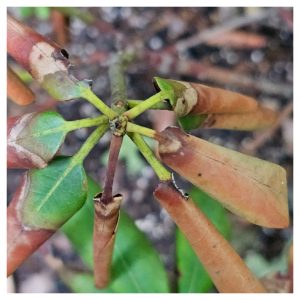
How to Prevent Iron-laden Well Water from Staining Foliage
Here are a few principles to keep in mind.
- Don’t be a lazy-ass (like me). There have been two times that the foliage of the plants in my garden has been stained by my iron-laden well water, and on both occasions, my own actions were the cause. My typical (and successful) watering MO includes using a gun or a wand to direct my well water toward the base of each plant, while minimizing any spraying of its aerial structures (foliage, stems, branches, and the like). This is a very effective methodology, but it’s also incredibly time consuming. So, on the two occasions that my actions caused my nasty well water to stain foliage in my garden, I took the low road and set an oscillating sprinkler with a broad coverage pattern out and let it saturate each area of my garden. For a few (3? 4?) hours in each section, while I worked on other things. (Remember, ferric iron particulate clogs soaker hoses in minutes, so using one of those was out). When all the sprinkling was done, I had a whole bunch of perfect, iron-infused well water-stained foliage on my hands. Shoulda watered by hand. Goddamnit.
- If you must use a sprinkler, cut down on the watering time. I’ve noticed, with the plants in my garden, that minimal drenching of their foliage with my hose (gun or wand) during my normal, effective watering activities doesn’t cause any visible staining at all. I can even put the very same villainous oscillating sprinkler out for short intervals (15-25 minutes or less) without any (or very little) visible foliage staining. But, does well water stain foliage when you sprinkle it on for too long? You better believe it.
- Some plants are more susceptible than others to well water foliage staining. In my garden, the plants that seem to really suffer from well water foliar staining are evergreens. Particularly, my rhododendron bushes. Roses, which pretty much hang on to the same leaves (except for those that are lost during regular deadheading or pruning) all season long also seem to be somewhat susceptible to well water staining, and so do hellebores. Hosta foliage, particularly that of the “blue” or really dark green-leaved varieties, also gets stained when it’s saturated with ferrous and ferric-heavy well water, but the health and well-being of these plants appears unaffected when this happens. The foliage of plants like hydrangeas (bigleaf and smooth), lilies, and daylilies, seems to be somewhat immune to well water foliage stains.
- All flowers in my garden get stained. No doubt about it. The petals of any flower that are drenched for an extended period of time with my iron-packed well water are gonna stain.
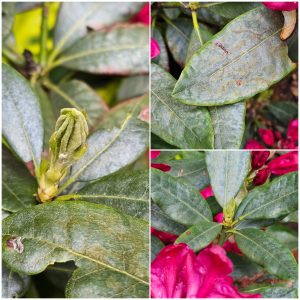
Why "Liquid Iron" Fertilizing Products Don't Stain Foliage
Chlorosis, iron, and soil acidity.
Chlorosis, or yellowing leaves, is a plant condition most often associated with an iron deficiency. But iron deficiencies in plants (particularly evergreens) growing in outdoor gardens typically don’t occur because the soil in which they grow is iron deficient, they occur because that soil isn’t sufficiently acidic. Lower pH levels – acidity – need to be present in soil in order for plants to assimilate the iron that’s almost always abundantly present there. Of course, there are soil acidifying products available commercially (generally elemental sulfur-based) that will effectively lower soil pH and allow chlorotic plants to effectively assimilate iron and ultimately green themselves up. Unfortunately, in the case of the application of these elemental sulfur-based soil acidifying products, the lowering of soil pH takes time. The elemental sulfur in the product must first be oxidized by microorganisms present in the soil for acidification to occur. As a “shortcut” to delivering much needed iron to chlorotic plants, fertilizing products sold as “liquid iron” are available. These quickly deliver iron – generally at the leaf level, in the form of a foliar drench – to these plants to eliminate, very quickly (but generally only temporarily – they typically need two or more applications to maintain their efficacy), the yellowing leaves of chlorosis. These products are most effective when used with soil acidifying products and organic granular food products that contain elemental sulfur. But even as a stand-alone treatment, “liquid iron” fertilizers are definitely effective at quickly eliminating the symptoms of chlorosis when they’re used to drench the foliage of afflicted plants. So, if the foliage needs to be drenched with liquid iron to remedy the symptoms of chlorosis, why isn’t the foliage stained during the drenching?
If iron in well water stains foliage, why don't "liquid iron" fertilizers?
Does well water stain foliage if it’s got ferrous and ferric iron in it? Check. Then why don’t liquid iron fertilizers stain foliage, too? The answer comes from the fact that each of these “liquid iron” fertilizers contain one of two water-soluble iron compounds, one with ferric iron (converted to a water-soluble form) as its base, and the other with the already water-soluble ferrous iron as its base. These compounds are the source of the “liquid iron” in the products. A typical “liquid iron” fertilizer will have, as its iron source, either ferric chelate (Fe³-EDTA)¹⁰ or ferrous sulfate (FeSO⁴).¹¹* In the case of ferric chelate, ferric iron is rendered entirely water soluble in this compound form by its EDTA component and highly absorbable for plants at both the foliar and root levels. And in the case of ferrous sulfate, ferrous iron remains entirely water soluble, stable (it doesn’t lose electrons and change into ferric iron), and highly absorbable by plants at both the foliar and root levels.
So, remember: Ferrous iron and ferric iron, in and of themselves, will cause well water to stain foliage. But either of the two iron compounds, ferric chelate (Fe³-EDTA) or ferrous sulfate (FeSO⁴), won’t. Easy peasy, right?
*Note: ferric chelate and ferrous sulfate are often listed as “iron chelate” and “iron sulfate,” respectively, in the ingredients lists of liquid iron fertilizer products that contain them.
Product Recommendation
I’m including this excellent product here as both an illustrative aid, and a wholehearted recommendation. The fact that ferrous and ferric iron-laden well water does stain foliage may have caused some confusion among those of you who were considering a liquid iron fertilizing product as a foliar drench solution to your chlorotic plants. In the immediately preceding section, I wanted to clarify the fact that the ferric chelate or ferrous sulfate compounds found in these products absolutely do not stain foliage. The product that I’m recommending below, is one longtime readers and subscribers may recognize. It contains iron in the form of ferrous sulfate, and it’s derived from seaweed that grows off the coast of Norway. Bear in mind that although ferrous sulfate-based liquid iron products like this one (and ferric chelate-based products, as well) deliver usable iron to plants almost instantaneously, if they’re used as a standalone treatment for chlorosis, the application process generally needs to be repeated one to several more times to maintain their benefits to the plant.¹²⁻¹³ This type of product works best when used in conjunction with other, longer lasting, sustained-feeding products, namely effective soil acidifiers and granular organic fertilizers containing elemental sulfur. Please read my RGG article from 2022, “How to Fix Yellow Rhododendrons (and Azaleas and Pieris, Too),” to learn my 4-step plan for fixing chlorosis in acid-loving evergreens. Naturally, it includes the use of the excellent product below, along with two other indispensable complementary products.
Remember this: Does ferrous and ferric iron-laden well water stain foliage? That’s a huge “YES.” But “liquid iron” fertilizing products containing ferric chelates or ferrous sulfates (like the product rec below) do not.
Ohrstrom’s Maxicrop Liquid Seaweed Plus Iron. Ohrstrom’s Maxicrop Liquid Seaweed Plus Iron is a remarkable source of iron for acid-loving plants. When used in conjunction with Espoma Organic Soil Acidifier and Espoma Organic Holly-tone, it literally works miracles. It’s got an N-P-K of 0-0-1 and it contains 2% iron. It’s sourced from Ascophyllum nodosum seaweed harvested from the waters along Norway’s coastline, and it contains iron in the form of ferrous sulfate (iron sulfate). The beneficial effects of this product are noticeable almost immediately after its application. Click the #advertisement link to learn more, or to order it here, from Amazon.
Watch The RGG YouTube Channel Video, "Does Well Water Stain Plant Foliage?"
The vid is actually not horrible, and it sort of summarizes the info in this article in a not entirely unwatchable format. In addition to the well water ferrous/ferric iron lowdown, it includes an actual, brief demo of the application of a liquid seaweed/ferrous sulfate foliar drench with Ohrstrom’s Maxicrop Liquid Seaweed Plus Iron (my liquid iron foliar drench of choice). Really, the video turned out to be not too bad. Click the image link below to watch “Does Well Water Stain Plant Foliage?”
Bibliography/For Further Reading
I used information from a number of excellent sources to help me write “Does Well Water Stain Foliage?” Below is the article’s bibliography/”For Further Reading” list. It contains each of the cited works in link form, so you can click on any one of them to give it a read if youi’ve got further interest.
- Gladis Zinati, Xiufu Shuai. “Management of Iron in Irrigation Water.” Rutgers New Jersey Agricultural Experiment Station Blog, December, 2005, p. 1.
- “Iron and Manganese.” Clemson Extension Water Quality: WQL 9, September, 1990, p. 1.
- Nicholas Dunn. “Iron in Your Water.” Evolve Quality Life Solutions Blog, September 29, 2021, pp. 2-3.
- Rosa Raudales, Juan Cabrera. “How to Address Insoluble Iron Issues in the Greenhouse.” Greenhouse Grower, July 25, 2019, p. 2.
- Jayashree Raman, Elizabeth (Nikki) Wyman, Dawn Mills. “Oxidation Definition, Process & Examples.” Study.com, pp. 1-4.
- Anne Marie Helmenstine. “Oxidation Definition and Example in Chemistry.” ThoughtCo., updated June 07, 2024, pp. 1-3.
- Olsen, R. A., & Miller, R. O. (1986). Absorption of ferric iron by plants. Journal of Plant Nutrition, 9(3–7), 751–757. https://doi.org/10.1080/01904168609363478
- “Field Notes.” Safe Water Technologies, Inc. Water Treatment Tips, p. 1.
- “Iron-oxidizing Bacteria.” Wikipedia, pp. 1- February 2021 – Vol. 7, No. 2, pp. 1-3, 5-10.
- “Ferric EDTA.” Wikipedia, pp. 1-4.
- “Iron(II) sulfate.” Wikipedia, pp. 1-10.
- Michael Kuhns. “Preventing and Treating Iron Chlorosis in Trees and Shrubs.” Utah State University Forestry Extension, updated 7-15-02, pp. 1-3.
- Jaap Lubbersen. “Iron chelate vs iron sulphates: What is the difference?” Royal Brinkman Knowledge Center, November 7, 2020, pp.1-6.
The "Does Well Water Stain Foliage?" Wrap-up
Does well water stain foliage? You know it does, baby. Plus, you know a lot more now, too. You know that well water containing iron’s two ionic forms, ferrous and ferric, makes it a brutal foliage-stainer. You know how to judiciously irrigate your own plants with iron-laden well water so as not to stain their foliage. You know that two iron compounds – ferric chelate and ferrous sulfate – when used in liquid iron plant fertilizers, do not stain foliage. You know which ferrous sulfate liquid iron plant fertilizer I absolutely love to use on my plants to keep them from turning chlorotic on me. You’ve got a link to an altogether not too horrible RGG YouTube Channel vid that includes a live demo and clarifies the “Does well water stain foliage?” issue. And you’ve got a great reading list that you can tap in the event that my article has failed to satisfy your hunger for plant-staining well water knowledge.
At this point, beyond thanking you for sticking this one out, and expressing my continued gratitude for your interest and readership, there’s nothing left for me to say except…
Cheers, and Happy Gardening!
The Renaissance Garden Guy is a participant in the Amazon Associates Program. As an Amazon Associate, The Renaissance Garden Guy earns from qualifying purchases.
Additionally, The Renaissance Garden Guy is a participant in the Bluehost, SeedsNow, and hosting.com (formerly A2 Hosting) affiliate programs. The Renaissance Garden Guy earns a fee/commission each time a visitor clicks on an ad or banner in this site from one of these companies and makes a subsequent qualifying purchase.
Please click here to view The Renaissance Garden Guy Disclosure page.
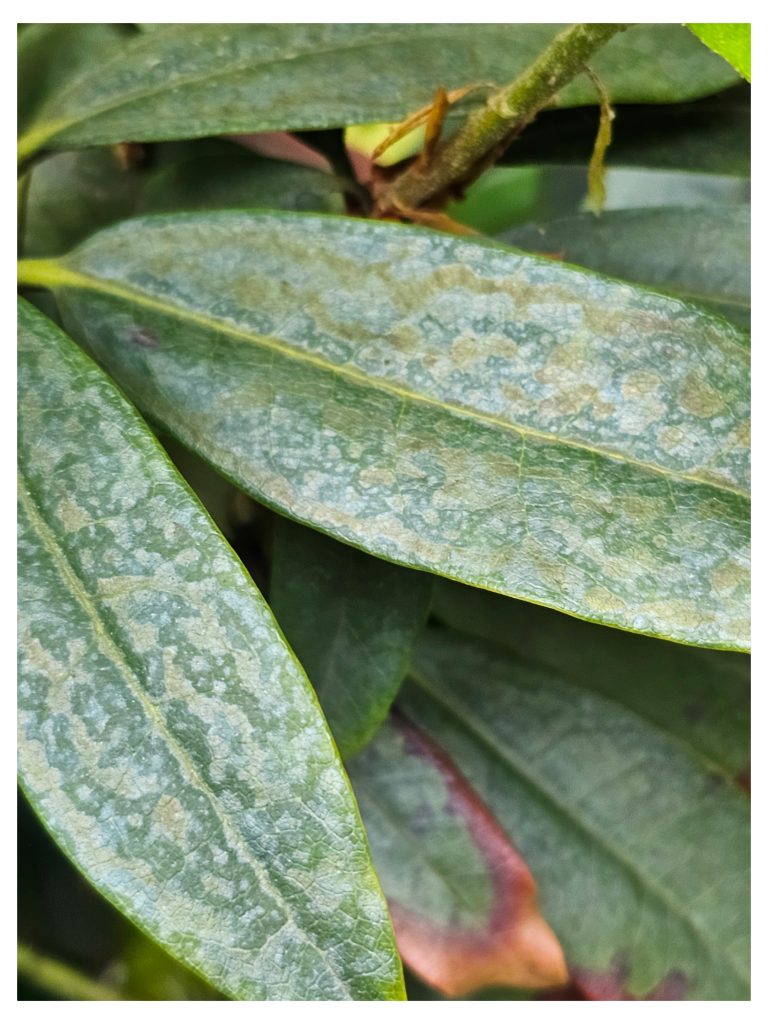

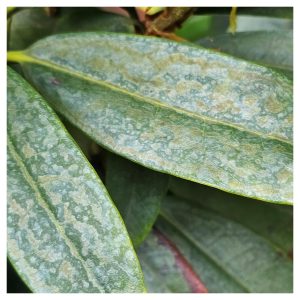
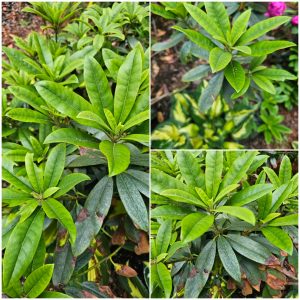

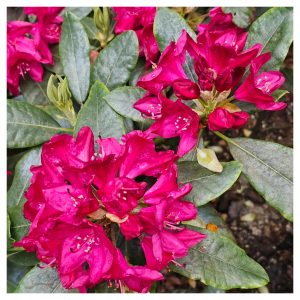


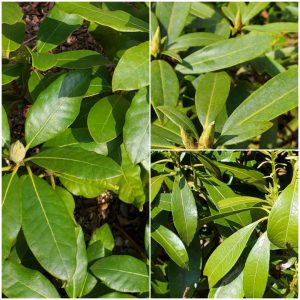



Amazing article, very interesting and informative!
As always, very well written, helpful and easy to understand.
Great image and video to illustrate the problem🙏🌸
Thank you so much for your truly kind words and thoughts, Roxxy. And, of course, thank you for reading the article! It’s really amazing how healthy that water is for plants when its flow is directed toward the ground and their root systems. It’s even more amazing how nasty it is when it coats their foliage. Thank you again, Roxxy, for your lovely kindness and genuine interest. I am very, very grateful.
Thank you for this amazing article. It was so informative.
Question — what do you and the people in your community use for drinking water?
Have a blessed day.
Thank you so much for reading the article, Annie, and for your very, very kind words. The water that’s used indoors at my house runs through a substantial water softening system. Even then, it’s still not at all good-tasting. It’s fine for washing dishes, showering, etc., but lousy for drinking. So, for drinking water, I do two things: 1) I have an additional filtering system that allows good-tasting water to flow through a dedicated tap, and 2) I have a water cooler for 5-gallon jugs of awesome drinking water. Easy peasy. Thanks once again for your kind interest, Annie, and for your kind words.
Wow. I had no idea how complex this can be. Very informative!
Thanks for giving this one a read, Lisa. It’s really amazing how much of this stuff is present in my well water. It’s impossible even to wash a car with my rusty, brown, iron-enriched water. Nasty!
Such detail in this article on iron and gardening!
Well water! Always thought calcium would be an issue but never thought Fe caused such issues!
Nice article John!
I really appreciate that, Waz. Thanks for reading it, and thanks for the great comment. I’ve got a little bit of experience with Wells and well water, and I’ve never seen such a concentration of Fe as I’ve got in mine. I can’t even wash a car with it eithout it staining. I do have some calcium, too, but nowhere near the levels of iron. Thanks again, Waz – I really appreciate it!
Very interesting subject. Exceptionally well written and full of useful information.
Thanks for reading it, Rick. It really is an interesting topic. Well water that’s heavily laden with ferrous and ferric forms of iron definitely presents irrigation challenges for hobbyist and professional ornamental gardeners, as well as commercial growers of agricultural crops. It’s definitely a good idea to identify and understand the kind(s) of iron – if any – present in the particular well water one is planning to use for irrigation. Thanks once again, Rick!
This article was very informative. The pictures and video really illustrated the problem and provided practical solutions. Thanks for the advice and product recommendations. I have ordered other RGG-recommendeded products here from Amazon and they have all been extremely helpful.
Thank you for reading the article and watching the video, Kevin. I’m glad you found it interesting and useful. And thank you for having confidence in my product recommendations. I’m glad you’ve had success using them. And, truly, I’d never recommend anything that hasn’t worked well for me. It’s all good stuff, and it’s all proven very, very effective in my garden. Thanks once again, Kevin.